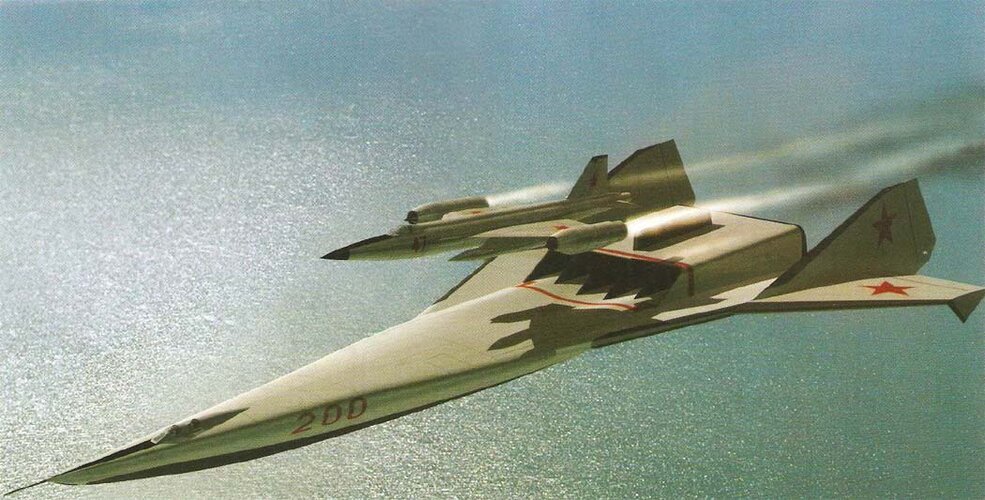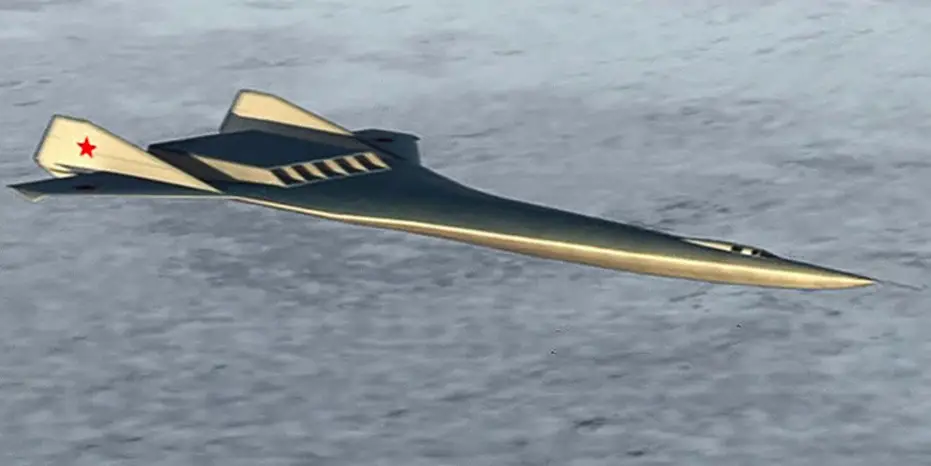The Bartini A-57 is the heaviest bomber ever built.
There were rumours about a revolutionary new aircraft design from the deepest parts of the USSR in the late 1950s. It would be a flying boat that could fly vertically, carry the largest nuclear weapon the Soviets could muster, and have its own parasite fighter capable of scouting defence and independent strikes. With only a crew of three and a range to reach the far-off shores of the United States, this flying monster could land anywhere—on water, land, snow, or ice—and would be refuelled from submarines in remote lagoons and lakes. However, this incredible concept from an even more incredible engineer never materialised, and the USSR lost out on what might have stemmed the tide of nuclear mania.
Welcome to the Bartini A57, the most overkill bomber ever created. Oh no, it’s a passenger jet being flown by adorable puppies that is bringing goodies to us all.
The atomic age had reached its full maturity by the late 1950s, and both nations were frantically developing new and horrifying ways to deliver intercontinental ballistic missiles or nuclear payloads. The cold war was at its height, pitting the military might and scientific minds of the United States and the Soviet Union against one another. The arms race between the two superpowers was at a fever pitch, and it appeared that things might soon heat up.

One such proposal of the USSR was the Bartini A57, which was envisioned as a huge seal-launched intercontinental bomber that wouldn’t need to take off from land-based airfields, which were always considerably more susceptible to enemy strikes during reconnaissance. Given that it was technically a flying boat, the way the Bartini a57 bomber was designed to accomplish this was, to put it mildly, inventive. The way it would take off and how it would be fueled were just two of the innovations devised by the a57 concept, and there’s a good reason why the Bartini a57 has been dubbed a beast of an aircraft.
Let’s get started, shall we? The a57 was designed in 1957 and would have carried a 244n thermonuclear bomb, which is significant for the period because 1957 was right in the middle of the hyper-paranoid atomic age and an escalating arms race. Despite being a large bomber carrying a city-destroying nuke, the a57 would only have required a crew of three. It would have weighed 320 tonnes or 705 pounds and measured 69.5 metres.
Importantly, the a57’s aerodynamic configuration was fairly groundbreaking for its day, especially with regard to its large spread wings. Although meant to avoid land-based airfields, the a57 was nevertheless fitted with skids for aircraft landings if it needed to. The wing’s leading edge featured a sweep angle that changed to a step, simplifying the load-bearing surface and producing what is known as a self-balancing wing.

This characteristic of the aircraft’s wings improved its aerodynamic performance and allowed it to achieve subsonic and supersonic speeds very easily, especially for a big flying boat bomber of the time. The Bartini wing for water takeoff was developed from this wing design. The aeroplane was also equipped with a ski chassis made up of underwater wings and hydro skis. The a57’s landing gear also made it possible for it to take off and land on snow and ice in addition to on land and water.
The a57 is thought to be able to take off from any unpaved airfield with a runway no shorter than 3,600 metres (9,500 feet) in length as well as from a smooth, snow-covered strip with a length of 3,600 metres (12,00 feet), so as you can see, this plane really was designed to take off from anywhere at any time.
It’s important to note that having the capacity to take off from snow and ice would have allowed aircraft to use forward-based airfields on arctic icefalls or even icebergs that were migrating south into the Atlantic Ocean.
The Yee 57, a smaller short-range flying boat that could reach targets in Europe that were closer to the soviet union’s borders, was created in the a57 because its apparent target was the United States. The name yee 57 is taken from the Russian term for Europe, euvropa.
one of the innovations of the a57 was the way it would take off; it would accomplish this by using vertical jets for needed thrust and lift. Given this aircraft’s size and bulkiness as a large boat plane, highly efficient and potent turbojet lift engines were significant features of this aircraft.
The nk10b or p10-b engine, which had an afterburner thrust of just 24 000 kilogrammes or 52 000 pounds, was chosen as the engine for the aircraft because it was logically positioned to face downward to aid takeoff from water surfaces. With five of these engines on board, the a57 should have been able to fly at a cruising speed of 2,600 kilometres per hour and a climbing height of 24, 000 metres. With a maximum takeoff weight that would have ranged between 270 and 305 tonnes, the aircraft could carry plenty of fuel and nuclear bombs to travel over great distances.
As ambitious and possibly even overly ambitious as the A57 project sounded, there was a conceptually sound rationale for it—at least if one takes into account what aircraft designer Robert Bartini had to say Bartini was of the opinion that there were key issues or challenges that face strategic aviation, meaning that any military aircraft should meet the following requirements.
- it should be able to penetrate any point of the enemy’s territory
- 2 it should provide the least vulnerability possible from an enemy’s air defence systems
- it should remain as hidden as possible before reaching or attacking
its target - it should be able to approach from any tactically advantageous area such as snow ice ground or water.
- it should be independent of stationary runways and launching grounds that are costly and leave military assets exposed Bartini made some very good points in his estimation of what is needed for an ideal military aircraft and in his mind the a57 came closest to achieving the objectives needed to overcome that list of challenges, in particular, the a57 would be perfect for achieving its fifth challenge namely ensuring that fixed land-based runways could be avoided if not obsolete
Nevertheless, what about the little fighter jet that we have so far seen in these 3D renderings? Later iterations of the a57 design also included a twin-engine aircraft known as a parasite fighter that would accompany and conduct reconnaissance missions over enemy territory with the considerably bigger bomber.
The cybin 2rs, later known as the rsr, was a fighter jet that could piggyback an A57 while travelling at its top speed of 2,600 km/h, or 1,600 mph. The two aircraft could cover targets within a radius of 5,000 km, or 3,107 miles. Pardon my poor pronunciation of “rsr,” but the two aircraft could cover targets within a radius of 5,000 km or 4,600 km.
The Bartini A57 was never a physical aircraft. The later rsr reconnaissance aircraft’s dimensions and weight were very similar to those of a cruise missile, which was obviously not by accident. Had it actually gone into development, we might have seen this plane carry or be a launching platform for bigger missiles, or perhaps even something to reach orbit. But we ain’t done yet because what they designed next was the smaller saibin 2rs fighter jet.
Only submarines operating at sea would be able to handle this large bomber. Commentators have noted that flying boats, which is what the a57 bomber was essential, are not made for waves and require flat, shallow water on which to land and manoeuvre. Rivers, bays, or lagoons are the best places for them to do this. Submarines, on the other hand, are the complete opposite and detest operating in relatively confined spaces like rivers, bays, or lagoons.
It’s worth taking some time to talk about the man who the plane was named after, Robert Ludwigovich Bartini, who was originally from Italy and came from a noble Italian family in his time. He would go on to become a pioneer of amphibious aircraft and ground effect vehicles, earning the soviets’ nickname “the soviet nick” for his invention. He was granted Soviet nationality.
He built seaplanes for the central design bureau, rising to become director of the department for experimental amphibious aircraft.








